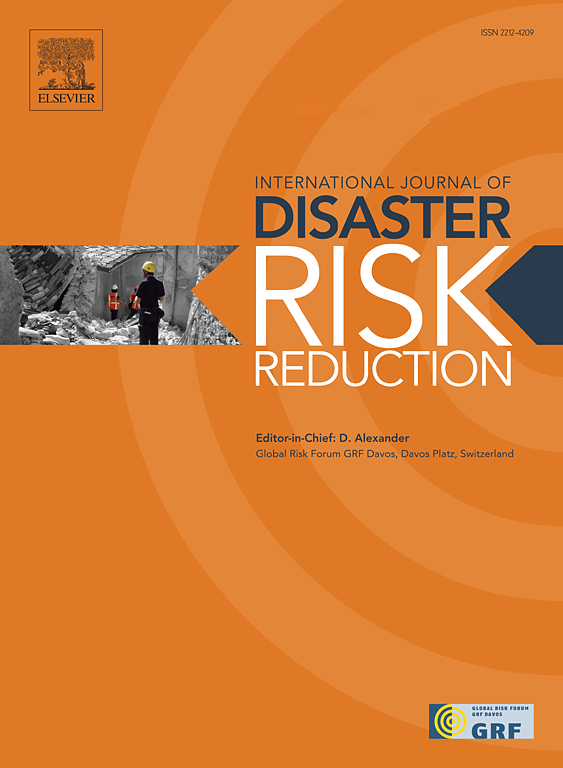Firing the imagination? A visual analysis of bushfire preparedness videos from Australian fire agencies, 2015–2022
IF 4.2
1区 地球科学
Q1 GEOSCIENCES, MULTIDISCIPLINARY
International journal of disaster risk reduction
Pub Date : 2025-06-13
DOI:10.1016/j.ijdrr.2025.105644
引用次数: 0
Abstract
Australian fire agencies use videos to inform and advise the public about strategies and actions they can take to prepare for bushfire danger. This study examines videos about bushfire preparedness published on YouTube by Australian state and territory fire services over the period 2015–2022. Through visual analysis, we investigate the explicit and implicit messages of videos by fire agencies about public bushfire risk in Australia. Quantitative content analysis of actors, settings, actions, and messages present in videos reveals a lack of representation of diversity in Australian society, and an overwhelming focus on risks faced by nuclear, home-owning families of European ancestry in low-density residential landscapes. Analysis is informed by the concept of social imaginaries – socially-embedded structures of perception that integrate expectations, aspirations, and images in shaping communication in cultural settings. Videos reproduce an imaginary in which women are positioned as guardians of families, and responsible for children's safety, while men are identified with the role of the firefighter. Fire itself is imagined as an external enemy within settler-colonial histories, and the nuclear family home is embedded in an imaginary of private economic responsibility and stability. These colonial, national, and neoliberal imaginaries about fire shape contemporary bushfire communication, despite the profound material changes to Australian populations and cultures over recent decades. We conclude that identifying, understanding and questioning culturally embedded imaginaries in fire agency communication can improve public communication about bushfire preparedness.
激发想象力?澳大利亚消防机构2015-2022年森林火灾防范视频的视觉分析
澳大利亚消防机构使用视频向公众通报和建议他们可以采取的应对森林火灾危险的策略和行动。本研究调查了2015-2022年期间澳大利亚州和地区消防部门在YouTube上发布的关于森林火灾防范的视频。通过视觉分析,我们调查了澳大利亚消防机构视频中关于公共森林火灾风险的显性和隐性信息。对视频中出现的演员、场景、行动和信息的定量内容分析表明,澳大利亚社会缺乏多样性的代表性,并且过度关注欧洲血统的核心家庭在低密度住宅景观中面临的风险。分析是由社会想象的概念提供的——社会嵌入的感知结构,在塑造文化背景下的交流中整合了期望、愿望和形象。视频再现了一种想象,在这种想象中,女性被定位为家庭的监护人,负责儿童的安全,而男性则被认定为消防员的角色。火本身被想象成移民-殖民历史中的外部敌人,核心家庭住宅被嵌入到私人经济责任和稳定的想象中。尽管近几十年来澳大利亚人口和文化发生了深刻的物质变化,但这些关于火的殖民、民族和新自由主义的想象塑造了当代丛林大火的传播。我们的结论是,识别、理解和质疑消防机构沟通中的文化嵌入想象可以改善公众对森林火灾防范的沟通。
本文章由计算机程序翻译,如有差异,请以英文原文为准。
求助全文
约1分钟内获得全文
求助全文
来源期刊

International journal of disaster risk reduction
GEOSCIENCES, MULTIDISCIPLINARYMETEOROLOGY-METEOROLOGY & ATMOSPHERIC SCIENCES
CiteScore
8.70
自引率
18.00%
发文量
688
审稿时长
79 days
期刊介绍:
The International Journal of Disaster Risk Reduction (IJDRR) is the journal for researchers, policymakers and practitioners across diverse disciplines: earth sciences and their implications; environmental sciences; engineering; urban studies; geography; and the social sciences. IJDRR publishes fundamental and applied research, critical reviews, policy papers and case studies with a particular focus on multi-disciplinary research that aims to reduce the impact of natural, technological, social and intentional disasters. IJDRR stimulates exchange of ideas and knowledge transfer on disaster research, mitigation, adaptation, prevention and risk reduction at all geographical scales: local, national and international.
Key topics:-
-multifaceted disaster and cascading disasters
-the development of disaster risk reduction strategies and techniques
-discussion and development of effective warning and educational systems for risk management at all levels
-disasters associated with climate change
-vulnerability analysis and vulnerability trends
-emerging risks
-resilience against disasters.
The journal particularly encourages papers that approach risk from a multi-disciplinary perspective.
 求助内容:
求助内容: 应助结果提醒方式:
应助结果提醒方式:


